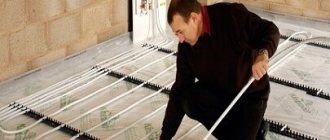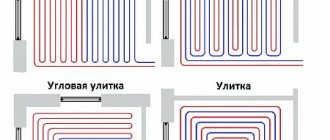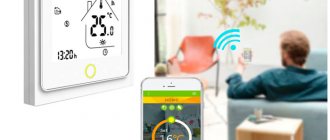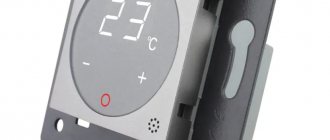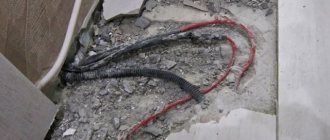Warm floors are a practical, modern and efficient heating system that is gaining popularity and is actively used in new apartments. It is not very expensive and is accessible even to citizens with average incomes. In addition, unlike a water system, infrared heated floors under laminate are much easier to implement, which is another plus.
Principle of operation
Conventional heating systems operate using a direct heat exchange scheme. For example, batteries receive energy from hot water, which is heated at a nearby boiler house. This energy is then transferred to the air in the room, thereby spreading heat throughout the room. The same thing happens when using electric heaters, only the heating element is heated there.
In heated floors created on the basis of water or electric (not infrared) systems, the simplest heat exchange also occurs, only in this case the screed, under which the cable or pipes are located, is heated. The disadvantage of such systems is inertia. To preheat the floor, you need to spend a lot of resources, but the cooling of the floor when the power is turned off occurs slowly, since the pipes or cables under the screed do not cool down for some time.
Film heated floors under linoleum or tiles work differently. Here, under the surface (tile, linoleum or laminate) there are transparent polyesters with carbon-coated strips (or paste). Each strip is connected to a copper bus—voltage is applied to it. When current passes through carbon paste, a radiation flux with waves 5–20 μm in length is created. The film itself and the tire heat up very little. The infrared energy flow created warms the surfaces it hits, and in this case it is the floor. Consequently, in infrared systems there are no intermediate surfaces through which heat is transferred; here the floor itself is heated - it is this that is the first and last “obstacle” to heat. An analogue is the sun, which is also a source of thermal infrared radiation. Its rays heat surfaces encountered along their path.
The operating principle of infrared systems has long been known and is successfully used in wall, ceiling or wall-mounted heaters. It has successfully proven its effectiveness over the years. With the development of technology, we have learned how to lay infrared heated floors under a laminate or other covering. This became possible due to the development of carbon-coated film heaters.
Choosing material
Mats for warm water floors
When choosing such a material, you must follow certain criteria
There are several important points that you should also pay attention to, for example, the thickness and quality of the installed substrate.
The material must have the following properties:
- high level of resistance to mechanical and temperature deformation;
- corresponding indicator of thermal insulation and waterproofing materials;
- the material used must be classified as environmentally friendly and at the same time safe;
- use should be convenient and simple. This will save your own time and effort during installation work;
- the material must have heat-reflecting properties;
- must have excellent soundproofing characteristics;
- the material must be able to withstand any, even the most drastic, temperature changes.
A foil surface material can be used on the floor. For installation of a warm water floor, it is the most optimal and a high-quality substrate is made.
The most popular types of substrates are:
- Tuplex products. This thickness is no more than 2.5 mm, while they are characterized by the presence of excellent heat-reflecting characteristics and waterproofing properties.
- High performance characteristics.
- Foil self-adhesive fabric. The thickness is about 7.5 mm. Use on difficult surfaces. It has a high heat transfer rate and waterproofing properties. It is worth considering the presence of soundproofing properties.
- PPS foil. It can be sold in different thicknesses, and the higher the indicator, the better thermal insulation qualities the material has. Has reflective ability.
- PE one-sided laminated. The undeniable advantages include a very small thickness (less than a centimeter), with high thermal insulation and waterproof characteristics.
- Foamed PE. With a very insignificant thickness, only 2 mm, it has truly excellent characteristics, including waterproofing and thermal insulation.
Advantages
There are a number of advantages inherent to these systems:
- Film thickness - 0.5 mm. This allows you to hide it under any covering, even thin linoleum. This same advantage allows you to implement a film heated floor with your own hands, since the labor-intensive work of pouring and screeding is eliminated. Also, this solution does not involve raising the floor level by centimeters, which is often the reason for using such a system in apartments with low ceilings.
- Uniform floor heating and stable temperature. If the heating elements are located under the laminate, which is very sensitive to temperature changes, then in the case of electric (non-infrared) or water systems there is a possibility of its damage due to a breakdown of the thermostat. When heated above 40 degrees, it may swell or diverge the seams. When using film systems, heating above 40 degrees is impossible even with a faulty thermostat, so laminate or linoleum or tiles will not be damaged.
- In multi-storey buildings, the use of classic underfloor heating systems is sometimes impossible due to the need to fill, which can make the structure heavier. The only possible option is the use of film infrared systems.
- Flexibility - the system can be implemented in all rooms, even with high humidity. You can install infrared heated floors under tiles, laminate, linoleum, or parquet boards. That is, the system can be implemented even in a bathroom or toilet, but since these rooms have a high level of humidity, and water always gets on the floor, grounding or the presence of a protective shutdown device in the electrical circuit is mandatory.
- Energy transfer begins almost instantly when power is turned on. This allows you to quickly bring the room temperature to a comfortable one. Such a system works perfectly with fashionable “smart home” technology and is programmable. That is, you can set the exact time for turning the heating on and off or specify the required temperature - it will be maintained in the room all the time.
- Unlike conventional electric or water radiators, infrared heated floors under linoleum do not burn oxygen or dry out the air, which is especially pleasant for people suffering from chronic respiratory diseases.
- No vortex flows. Conventional radiators on the walls draw in cold air from below and release hot air from above, which moves to the top of the room, cools and sets. As a result, powerful streams are created that drive dust around the room. The infrared floor heats up evenly and slightly, which eliminates point turbulence.
Well, the last plus is the price. Installation of a film heated floor under linoleum will cost much less than the implementation of complex water cooling of the floor. We are talking about the cost of installation, not the film itself. However, depending on the manufacturer, the film itself may be cheaper than “outdated” floor heating systems.
Types of lining materials
Foil polystyrene.
High heat/noise insulation characteristics, water resistance. The heat-reflecting effect is provided by a layer of foil. One of the most expensive substrates. Another foil backing for water heated floors is foamed polyethylene coated with foil. Two-millimeter thick film. Reflective effect, good heat/noise insulation characteristics. Cons: wrinkles easily, not waterproof enough. The price is the lowest.
Single-sided polyethylene: one side is foil-coated, the other is laminated with polyethylene. Thickness is 8 millimeters, waterproofing is better than the previous material, the price is higher.
Foil self-adhesive polyethylene 8 mm thick. All the necessary characteristics are in order, easy to install, and hides minor unevenness of the base well. The price is average.
In addition to foil, reflective Mylar film is used for laminating polyethylene. The thickness of such a substrate is three millimeters, and the price is higher than that of foil polyethylene. The material is valuable when laying electric floors, because... does not conduct current (unlike foil). For installation under a water floor, it has no advantages over foil pads.
Cork lining for a warm water floor. Does not crack, does not rot, and is resistant to fungal infections (unlike most wood materials). High thermal insulation and noise-absorbing characteristics, environmental friendliness. There is no thermal expansion. Not the most expensive material, since in fact it is made not from balsa wood, but from crushed oak bark.
Cork comes with or without a foil layer. In the second case, the foil is purchased separately and placed between two layers of insulation. The material is sold in slabs and rolls.
Extruded polypropylene. All the necessary characteristics are excellent, there is a foil layer. Mechanical strength, heat resistance. Sold in mats up to ten centimeters thick. The price is average.
A separate category of lining materials is a substrate for a water-heated floor with bosses. On most substrates, pipes are laid according to markings, and reinforcing mesh is used for fastening. The surface of the mats with bosses consists entirely of raised projections, between which pipes are laid.
The bosses not only mark the laying line, they also fix the pipes, preventing them from moving to the sides. Additional fixation - with clips and staples (not required for all mat models).
The mats () are made of polystyrene foam: a material with low thermal conductivity, waterproof, and a good sound insulator. If there is no foil layer, installation of reflective metal plates is necessary.
Another advantage of such mats is that they are equipped with locks for connecting to each other, which greatly simplifies the installation procedure. Minus - they are expensive compared to other materials.
Alignment
The very first stage is leveling the floor. Naturally, the old coating must be completely removed, the surface washed and dust removed. If small holes remain in the floor slab itself (they can form during the construction of the house), then they can simply be filled with sand.
If the floor is flat, then it is necessary to lay a special material directly on it to reflect thermal radiation. The underlay for film heated floors is inexpensive and is laid over the entire area - close to the walls. To avoid shifting, this material can be attached to the floor with double-sided tape - just glue it around the perimeter. The presence of a heat-reflecting surface increases the efficiency of the heated floor and significantly reduces heat loss through the bottom. If the floor had holes, then this material will completely cover them.
Heating elements are the very “heart” of a warm floor.
- Heat-reflecting material - its purpose is to reduce heat loss. A prerequisite is that it must be non-conductive. Polyethylene foam insulation or cork backing with a reflective layer is suitable.
- The base of the floor is solid and level. To do this, the concrete base can be filled with a leveling compound, and plywood can be laid on the wooden base.
Placement of thermal film
Before placing the film itself, you need to plan its position in the room and draw up an approximate connection diagram for the film heated floor. To do this, you need to know in advance the future location of the furniture in the room, since infrared elements should not be located under a closet or sofa. If there is no clear plan, then it is advisable to place the film at a distance of 60–70 cm from the walls.
In residential premises, a standard arrangement of thermal film is often used: several strips in the center of the room along the long side. When the location has been decided, the film strips must be cut into pieces of the required size and laid on the floor with the copper film down or up (depending on how indicated in the instructions). Moreover, they should be positioned so that the eyeliner is on one side.
The distance of the stripes from each other is individual. One manufacturer allows them to be placed end-to-end (most often), another recommends leaving a space of 3-4 cm between the strips. But no one ever allows stripes to be placed overlapping - this is fraught with overheating and failure.
If the distance between two or three stripes is higher than permissible, this will lead to uneven heating of the floor - there will be less and warmer areas on it with a difference of 2-3 degrees, although they are not easy to notice.
Insulation
The thermofilm usually comes with a special insulating tape with special clamps that are used to connect the floor to the network. Also included are cables, a temperature sensor and a thermostat (not always). Cables usually have a cross-section designed to carry a current of a given power.
Use bitumen film to cover the cut areas of the tire. First of all, they are glued to areas of the side to which wires are not connected. Simply put, it closes “open” contacts. The film must be glued well, that is, without an air bubble. When voltage is first applied, the film heats up, melts slightly and takes the shape of the compound being protected.
On the reverse side of the strip there is an open contact. A clip is attached to each of them - it is included in the kit. You need to install it using pliers so that the special spikes pierce the film and reach the tire itself. The stripped ends of the cable are attached to the clips in accordance with the instructions (it clearly indicates where the phase, neutral, and ground are connected), the open contact is covered with bitumen films. The underfloor heating strips are connected to each other in series so that when voltage is applied they work simultaneously. It is also advisable to fasten them together with tape to prevent them from moving under linoleum or laminate or tiles.
What type of substrate should be used for the water system?
The main condition for a heated floor system is to ensure an increased degree of heat transfer. In this case, heat will not be wasted. Provided that the floor is based on pipes, the underlay in the event of an accident will perform an additional waterproofing function.
Sometimes you can use a special molded foam cover that is very easy to secure the pipeline into. The same coating acts as a substrate
Typically, a typical base for the substrate is foil, which helps to reflect heat, which should not go to heating the ceilings of the neighbors below. If the foil is sufficiently thick, it can be in its pure form or on a polymer base (glued in a thin layer). In principle, the heat insulator has a low degree of waterproofing. This protection must be ensured by laying a separate layer of insulating material.
The substrate does not need special fastening, since it is laid on the insulation. When installing a water heated floor, a reinforcing screed is used, which presses down the substrate
The main difference when comparing identical underlayment models is the cost and different service life. And the modern market offer does not yet offer a wide range.
Connection
The ends of the cables are connected to the thermostat, which should be mounted on the wall. It may not be included in the kit; sometimes the regulator needs to be purchased separately. In addition to “phase” and “zero”, you also need to connect the temperature control sensor cable to the thermostat. The sensor itself fits under the black stripes of the film - it measures the temperature on them, which allows the system to accurately control the heating. Since the sensor has some volume, it can create a bulge on the floor. To ensure the floor is level, a small hole is cut out in the insulating material for it.
The thermostat is installed on the wall - in a place to which residents have free access. Cables are connected to it: phase, neutral, grounding, from the temperature control sensor. The connection is carried out according to the instructions of the selected thermostat or the heated floor itself, but everything is intuitively clear to a person who at least has experience installing and connecting conventional sockets. If a film heated floor under carpet, laminate or tile is made of several elements, then you cannot twist the wires from them - there are certified terminal connections for this.
Before you connect an infrared heated floor to your home wiring, you need to know what load it is designed for. Most often, if the floor power exceeds 2.5 kW, then the wire from the regulator is led into the panel - to a separate machine. It would be stupid to “hang” such a powerful system on the home wiring. When everything is connected, the system is tested. If everything works fine, then you can proceed to the next step.
Preparing the foundation
The subfloor must be smooth and clean - litter and large debris are not allowed, it is also important to remove pebbles, sand, and dust. It is recommended to check the floor for strength, repair cracks and gaps, and level them to acceptable parameters.
Advice! To make the concrete base less dusty, it is recommended to treat it with a primer mixture, although this procedure is not necessary.
Also, thermal insulation material should be laid on the subfloors. It is recommended to use foil. The shiny side should be up. The strips are laid end to end. The thickness of the foil material should be about 2-3 mm. It is most convenient to secure the material using double-sided tape, and the gaps between the individual strips can be closed with ordinary tape. Then small recesses will be cut out of the material into which terminals, wires and other communications are placed. Then the base for the capricious laminate will be optimally smooth. It is also recommended to lay a layer of waterproofing material on the base of the floor.
Laying foil insulation
Laying waterproofing and laminate
To protect the floor elements from water ingress, a waterproofing film is placed on it. It has no relief and is very thin, so it does not affect the efficiency of the installation and freely transmits infrared radiation. The waterproofing layer is not applied over the entire floor area, but on the films themselves with protrusions along the edges. Well, then comes the laying of laminate, tiles, linoleum or parquet boards. This is how you install a film heated floor with your own hands. That is, everything here is intuitive even for the most inexperienced master.
As for laying the flooring, standard schemes are used here.
Is additional thermal insulation necessary or not?
Additional thermal insulation when installing an infrared floor is aimed at:
- Protection of the heated room from the penetration of cold air flows from outside;
- Saving heat indoors and preventing it from escaping outside.
The need for additional insulation depends on a number of factors:
- In what room is the floor installed? If it is located on the ground or above the basement, then the thermal insulation layer should be thicker.
- What kind of substrate is laid - that is, the type and its thickness. When using a thin foil product as a flooring, insulation made of expanded polystyrene foam, cork or polystyrene foam is required.
If you do not adhere to these rules, the floor will not work efficiently (heat will be wasted), and this will entail additional costs.
Exploitation
After the film infrared heated floor is installed under the laminate, it is necessary to save a plan for its placement in the room, indicating the distances from the walls. This will allow you to rearrange the room correctly, moving the furniture elements to areas with infrared stripes. If you need to install any elements on the floor with fastening to the ceiling, then the layout of the heating elements will also come in handy.
When the connection of the infrared heated floor is completed and the floor covering is laid on top of it, it is not recommended to turn on the installation immediately at full power. Linoleum or laminate must “adapt”, so to begin with it is advisable to set the temperature to 15–20 degrees, adding 3–4 degrees every day. If tiles are laid on the floor, the adhesive (or mortar) on which it is fixed must first dry at natural temperature. And a slow increase in temperature will allow you to understand the full efficiency of the film heated floor under the tile or laminate and determine the optimal value.
Stability of characteristics
Groups of porous materials, such as polyethylene foam and expanded polystyrene, have an unpleasant feature. Over time, under the influence of static stress (burden from lying pipes and the load when walking on the floor) they are compressed. The thickness of the substrate decreases, the process may proceed unevenly, differing in different areas of the room. This can cause unpleasant consequences.
You need to select a substrate material based on the service life and physical characteristics declared by the manufacturer. Temporary changes in geometry are taken into account, as well as production technology. For example, expanded polystyrene foam has an open structure and sticks together over time. At the same time, extruded has completely closed cells, is elastic, retains its geometry and properties for decades.
Manufacturers
Speaking about which film heated floor is better, we can give examples of different manufacturers offering effective solutions. Today the most popular manufacturers are Daewoo, Caleo, Heat Plus
Caleo is considered the best brand - this is a South Korean company that offers cool modern solutions in the form of infrared heated floors for laminate, parquet boards, and tiles. Kaleo films are reliable and durable, very thin; if installed correctly, they will last for ten years, the only drawback is the fragility of the product. The thickness of the film is only 0.42 mm, so when laying infrared heated floors under laminate or linoleum it is necessary to do it very carefully, otherwise you can simply damage the film.
Heat Plus is a popular brand that produces premium films. If you need to install an infrared heated floor with your own hands under the tiles, then with a high probability you will have to choose films from this manufacturer, namely the “Silver” model. It has a high melting point, which makes it safe and effective when used with ceramic tiles.
Which laminate is better to use in conjunction with infrared heated floors?
For normal operation of IR heated floors, it is important to choose the type of coating. Otherwise, the lamellas will deform over time, conduct heat poorly, and the release of formaldehyde will exceed permissible standards.
Laminate for a warm film floor must meet the following requirements:
- have only a locking connection, since the use of glue is not allowed for laying the lamellas: the seam is too rigid and breaks due to temperature changes;
- have a high thermal conductivity (0.05-0.10);
- the thickness of the panel should be 8-9 mm; with a smaller height of the element, the locking connection is destroyed, with a larger height, heat is poorly transmitted;
- when heated, do not emit formaldehyde above the established norm - the coating must correspond to classes E0 or E1, as well as K1;
- have high wear resistance (not lower than class 3).
Laminate should be purchased based on the listed requirements. When purchasing, you must ensure that the instructions or packaging contain special markings indicating the possibility of using the coating in conjunction with heating elements.
Markings on laminate packaging for heated floors


